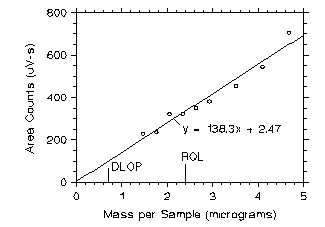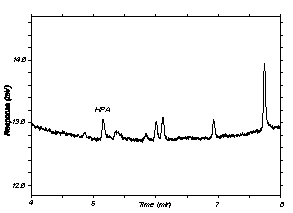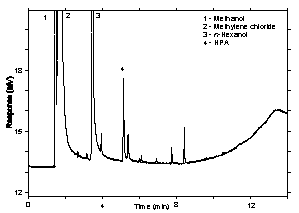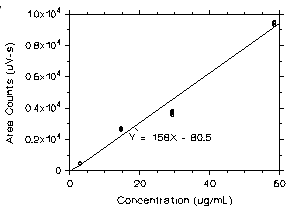1. General Discussion
1.1 Background
1.1.1 History
The validated
OSHA Method 92 for ethyl acrylate and methyl acrylate uses coconut
shell charcoal coated with 4-tert-butylcatechol (TBC) to collect
samples which are desorbed with carbon disulfide. This collection
procedure was tried with 2-hydroxypropyl acrylate HPA) but a low
desorption efficiency was observed. Other solvents such as carbon
disulfide with 1% dimethyl formamide and toluene were explored with
both TBC-coated charcoal and non-coated coconut shell charcoal but a
low desorption efficiencies were also observed. Desorption with 95/5
(v/v) methylene chloride/methanol using coconut shell charcoal coated
with 4-tert-butylcatechol gave 100.17% average recovery.
1.1.2
Toxic effects (This section is for information only and should not be
taken as the basis of OSHA policy.) (Ref. 5.1)
Acute toxicity
studies indicate HPA to be more toxic than the corresponding ethyl
derivative 2-hydroxyethyl acrylate (HEA). The rat oral LD50
was 0.25-0.5 g/kg; the skin absorption LD50 in rabbits
about 0.25 mg/kg.
Direct contact caused severe eye burns and
was corrosive to skin. Some sensitization was caused in guinea pigs.
Inhalation at 650 ppm for 7 hours was not fatal to rats, however,
industrial exposures for humans have been below 1 ppm. A 30-day
inhalation study in rats, dogs, rabbits and mice (assumed to have been
7 hours a day, 6 days a week) indicated some irritation at the lowest
level of 5 ppm.
A 8 hour time-weighted average TLV of 0.5 ppm
is recommended, based on irritant effects. As with HEA, the margin of
safety is judged not to be unduly large. Inhalation of 2-hydroxypropyl
acrylate irritates nose and throat and causes coughing. Lung injury
may also occur. Ingestion causes irritation and burning of mouth and
stomach. Vapors irritate the eyes. Contact with the liquid causes
severe burns of eyes and skin. In animals, sensitization has been
observed in exposed animals.
1.1.3 Workplace exposure (Ref.
5.1)
2-Hydroxypropyl acrylate is a monomer used in the
manufacture of thermosetting resins for surface coatings.
1.1.4
Physical properties and other descriptive information (Ref. 5.1 and
5.2)
| Synonyms: |
Propylene Glycol monoacrylate;
Acrylic acid, 2-Hydroxypropyl ester; 2-Propenoic acid,
2-hydroxypropyl ester; 1,2-Propanediol,
1-acrylate |
| CAS number: |
999-61-1 |
| IMIS: |
H156 |
| RTECS: |
AT1925000 |
| Molecular weight: |
130.14 |
| Boiling point: |
77°C @ (5 mmHg) |
| Odor: |
Faint unpleasant acrylate odor |
| Color: |
Clear colorless liquid |
| Density: |
1.045 g/mL |
| Molecular formula: |
CH2CHCOOCH2CHOHCH3
|
| Structural formula: |
 |
The analyte air concentrations throughout this method
are based on the recommended sampling and analytical parameters of 10
liters and a desorption volume of 1 mL. Air concentrations listed in ppm
are referenced to 25°C and 101.3 kPa (760 mmHg).
1.2 Limit defining parameters
1.2.1 Detection limit of the overall
procedure (DLOP)
The detection limit of the overall procedure
is 0.72 µg per sample (0.014 ppm or 0.072 mg/m³). This is the amount
of analyte spiked on the sampler that will give a response that is
significantly different from the background response of a sampler
blank.
The DLOP is defined as the concentration of analyte that
gives a response (YDLOP) that is significantly different
(three standard deviations (SDBR) from the background
response (YBR).
The direct measurement of YBR and
SDBR in chromatographic methods is typically inconvenient,
and difficult because YBR is usually extremely low.
Estimates of these parameters can be made with data obtained from the
analysis of a series of samples whose responses are in the vicinity of
the background response. The regression curve obtained for a plot of
instrument response versus concentration of analyte will usually be
linear. Assuming SDBR and the precision of data about the
curve are similar, the standard error of estimate (SEE) for the
regression curve can be substituted for SDBR in the above
equation. The following calculations derive a formula for the
DLOP:
 |
Yobs = observed
response
Yest = estimated response
from regression curve
n = total no. of data points
k = 2 for a linear
regression curve |
At point YDLOP on the regression curve
A = analytical sensitivity
(slope)
therefore
Substituting 3(SEE) + YBR for
YDLOP gives
Table
1.2.1
Detection Limit of the Overall Procedure
|
mass per sample
(µg) |
area counts
(µV-s) |
|
0
0.732
1.463
1.76
2.05
2.34
2.63
2.93
3.51
4.096
4.68 |
0
0
229
236
321
323
350
381
454
544
705 |
| |

Figure
1.2.1 Plot of HPA data to determine the
DLOP/RQL |
The
DLOP is measured as mass per sample and expressed as equivalent air
concentrations, based on the recommended sampling parameters. Ten
samplers were spiked with descending increments of analyte, such that
the highest sampler loading was 4.68 µg/sample. This is the amount,
when spiked on a sampler, would produce a peak approximately 10 times
the background response for a sample blank. These spiked samplers, and
the sample blank were analyzed with the recommended analytical
parameters, and the data obtained used to calculate the required
parameters (A and SEE) for the calculation of the DLOP. Values of
138.3 and 33.19 were obtained for A and SEE respectively. DLOP was
calculated to be 0.72 µg/sample (0.014 ppm, 0.072 mg/m³).
1.2.2
The reliable quantitation limit (RQL) is 2.40 µg per sample (0.045 ppm
or 0.240 mg/m³). This is the amount of analyte spiked on a sampler
that will give a signal that is considered the lower limit for precise
quantitative measurements.
The RQL is considered the lower limit for
precise quantitative measurements. It is determined from the
regression line data obtained for the calculation of the DLOP
(Section 1.2.1), providing at least 75% of the analyte is
recovered. The RQL is defined as the concentration of analyte
that gives a response (YRQL) such
that
YRQL - YBR =
10(SDBR)
therefore:
|

Figure
1.2.2 Chromatogram of the
RQL | 2. Sampling Procedure
2.1 Apparatus
2.1.1 Samples are collected using a
personal sampling pump calibrated, with the sampling device attached,
to within ±5% of the recommended flow rate.
2.1.2 Samples are
collected with 4-mm i.d. × 6-mm o.d. × 7.0-cm glass sampling tubes
packed with two sections of coconut shell charcoal that has been
coated with TBC, 10% by weight. The front section contains 110 mg and
the back section contains 55 mg of TBC-coated coconut shell charcoal.
The sections are held in place with glass wool plugs. For this
evaluation, tubes were purchased from SKC, Inc. (catalog no.
226-73). 2.2 Technique
2.2.1 Immediately before sampling,
break off the ends of the TBC-coated coconut shell charcoal tube. All
tubes should be from the same lot.
2.2.2 Attach the sampling
tube to the pump with flexible tubing. It is desirable to utilize
sampling tube holders which have a protective cover to shield the
employee from the sharp, jagged end of the sampling tube. Position the
tube so that sampled air passes through the reference, larger, section
of the tube first.
2.2.3 Air being sampled should not pass
through any hose or tubing before entering the sampling
tube.
2.2.4 Attach the sampler vertically with the reference,
larger, section pointing downward, in the worker's breathing zone, and
positioned so it does not impede work performance or
safety.
2.2.5 After sampling for the appropriate time, remove
the sample and seal the tube with plastic end caps. Wrap each sample
end-to-end with a Form OSHA-21 seal.
2.2.6 Submit at least one
blank sample with each set of samples. Handle the blank sampler in the
same manner as the other samples except draw no air through
it.
2.2.7 Record sample volumes (in liters of air) for each
sample, along with any potential interferences.
2.2.8 Ship any
bulk samples separate from the air samples.
2.2.9 Submit the
samples to the laboratory for analysis as soon as possible after
sampling. If delay is unavoidable, store the samples in a
refrigerator. 2.3 Desorption
efficiency
The desorption efficiencies (DE) of 2-hydroxypropyl
acrylate were determined by liquid-spiking TBC-coated coconut shell
charcoal tubes with 0.1 to 2 times the target concentration. These
samples were stored overnight at ambient temperature and then desorbed
and analyzed. The average desorption efficiency over the studied range
was 100.17%.
Table 2.3
Desorption
Efficiency of 2-Hydroxypropyl Acrylate
|
| |
% Recovered |
| |
0.1× |
0.5× |
1.0× |
2.0× |
| Tube# |
2.9 µg |
14.6 µg |
29.3 µg |
58.5 µg |
|
1
2
3
4
5
6
|
105.97
100.69
103.67
100.0
99.46
103.19
|
99.55
97.19
98.88
98.69
96.88
98.17
|
98.87
99.45
99.40
101.4
100.5
99.40
|
99.22
101.8
100.9
101.7
99.33
99.38
|
| average |
102.16 |
98.23 |
99.85 |
100.4 |
| overall average |
100.17 |
|
|
|
| SD |
±2.05 |
|
|
|
| 2.4
Retention efficiency
The TBC-coated coconut shell charcoal
sampling tubes were spiked with 58.52 µg (1.0 ppm or 5.85 mg/m³), 2-
hydroxypropyl acrylate, allowed to equilibrate 48 hours, and then had 10
L humid air (80% RH at 23°C) pulled through them at 0.1 Lpm. They were
opened, desorbed, and analyzed by GC-FID. The retention efficiency
averaged 92.72%. There was no 2-hydroxypropyl acrylate found on the
backup portions of the tubes.
Table 2.4
Retention
Efficiency of 2-Hydroxypropyl Acrylate
|
| Tube # |
A section
recovery (%) |
B section
recovery (%) |
total
recovery (%) |
|
1
2
3
4
5
6 |
90.62
92.13
93.35
95.46
90.58
94.20
|
0
0
0
0
0
0 |
90.62
92.13
93.35
95.46
90.58
94.20
|
| |
|
mean |
92.72 |
|
2.5
Sample storage
The front sections of six TBC-coated coconut
shell charcoal sampling tubes were each spiked with 29.3 µg (0.5 ppm) of
2-hydroxypropyl acrylate. Six more tubes had 10 liters of humid air (80%
RH at 23°C) drawn through them before they were spiked with 29.3 µg (0.5
ppm) of 2-hydroxypropyl acrylate. They were sealed and stored at room
temperature. Three dry samples and three humid air samples were analyzed
after 7 days and the remaining three samples of each were analyzed after
14 days. The amounts recovered indicate good storage stability for the
time period studied.
Table 2.5
Storage Test
for 2-Hydroxypropyl Acrylate
|
Dry Air Samples
|
Humid Air
Samples
|
|
|
time
(days) |
recovery
(%) |
time
(days) |
recovery
(%) |
|
|
7
7
7 |
96.63
99.81
99.88 |
7
7
7 |
95.53
97.21
98.53 |
| 14 |
98.43 |
14 |
94.65 |
| 14 |
99.14 |
14 |
92.41 |
| 14 |
95.08 |
14 |
97.51 |
| mean |
98.16 |
mean |
95.98 |
|
|
2.6
Precision
The precision was calculated using the area counts from
six injections of each standard at concentrations of 2.9, 14.6, 29.3,
and 58.5 µg/mL 2-hydroxypropyl acrylate in the desorbing
solution.
Table
2.6
2-Hydroxypropyl Acrylate Precision Study
|
injection #
|
2.9
µg/mL |
14.6
µg/mL |
29.3
µg/mL |
58.5
µg/mL |
|
1
2
3
4
5
6 |
444
451
450
473
481
454 |
2635
2627
2719
2700
2625
2689 |
3769
3748
3669
3744
3793
3570 |
9411
9318
9500
9517
9497
9408 |
| mean |
459 |
2666 |
3716 |
9442 |
| SD |
±14.7 |
41.6 |
82.5 |
76.8 |
|
2.7
Recommended air volume and sampling rate. Based on the data collected in
this evaluation, 10 L air samples should be collected at a sampling rate
of 0.10 L/min.
2.8 Interferences (sampling)
2.8.1 It is not known if any compounds
will severely interfere with the collection of 2-hydroxypropyl
acrylate on TBC-coated coconut shell charcoal tubes. In general, the
presence of other contaminant vapors in the air will reduce the
capacity of the TBC-coated coconut shell tubes to collect
2-hydroxypropyl acrylate.
2.8.2 Suspected interferences should
be reported to the laboratory with submitted samples.
2.9 Safety precautions
(sampling)
2.9.1 The sampling equipment should be
attached to the worker in such a manner that it will not interfere
with work performance or safety.
2.9.2 All safety practices
that apply to the work area being sampled should be
followed.
2.9.3 Protective eye wear should be worn when
breaking the ends of the glass sampling tubes.
3. Analytical
Procedure
3.1 Apparatus
3.1.1 The instrument used in this
study was a gas chromatograph, equipped with a flame ionization
detector, specifically a Hewlett Packard model 5890.
3.1.2 A GC
column capable of separating the analyte from any interferences. The
column used in this study was a 45-meter DB-5, 0.32-mm i.d., 1.0 µm
film thickness.
3.1.3 An electronic integrator or some suitable
method of measuring peak areas.
3.1.4 Two milliliter vials with
Teflon-lined caps.
3.1.5 A 10 µL syringe or other convenient
size for sample injection.
3.1.6 Pipets for dispensing the
desorbing solution. A 1-mL repipette dispenser was used in this
study.
3.1.7 Volumetric flasks - 5 mL and other convenient
sizes for preparing standards. 3.2 Reagents
3.2.1 Purified GC grade nitrogen,
hydrogen, and air.
3.2.2 2-Hydroxypropyl acrylate, Reagent
grade
3.2.3 Methylene chloride, HPLC grade
3.2.4
Methanol, HPLC grade
3.2.5 n-Hexanol,
Reagent grade
3.2.6 Desorbing solution; 95/5 (v/v) methylene
chloride/methanol with 0.25 µL/mL n-hexanol
internal standard. 3.3 Standard
preparation
3.3.1 At least two separate stock
standards are prepared by diluting a known quantity of 2-hydroxypropyl
acrylate with the desorbing solution.
3.3.2 A third analytical
standard should be prepared at a high concentration to check the
linearity of the detector response to the 2-hydroxypropyl acrylate.
For this study two analytical standards were prepared at a
concentration of 1 µL/mL (29.26 µg/mL) and one at 4 µL/mL (117.04
µg/mL) 2-hydroxypropyl acrylate in the desorbing solution of 95/5
(v/v) methylene chloride/methanol with 0.25 µL/mL n-hexanol internal standard.
3.4 Sample preparation
3.4.1 Sample tubes are opened and the
front and back section of each tube are placed in separate 2 mL
vials.
3.4.2 Each section is desorbed with 1 mL of the
desorbing solution of 95/5 (v/v) methylene chloride/methanol with 0.25
µL/mL n-hexanol internal
standard.
3.4.3 The vials are sealed immediately and allowed to
desorb for 60 minutes with occasional shaking. 3.5 Analysis
3.5.1 Gas chromatograph
conditions.
| Injection size: |
1 µL |

Figure
3.5.1 Chromatogram of the target
concentration.
|
| |
|
Flow rates (mL/min)
|
|
| Nitrogen (make-up): |
30 |
| Hydrogen(carrier): |
2 |
| Hydrogen(detector): |
60 |
| Air: |
450 |
Retention times (min)
|
|
| Methanol: |
1.45 |
| Methylene chloride: |
1.66 |
| n-Hexanol: |
3.44 |
| HPA: |
5.14 |
Temperatures (°C)
|
|
| Injector: |
180 |
| Detector: |
220 |
| Column: |
100°C for 5 min then 10°C/min to
180°C for 2 min |
3.5.2 Peak areas are measured by an integrator or other
suitable means. 3.6
Interferences (analytical)
3.6.1 Any compound that produces a
response and has a similar retention time as the analyte is a
potential interference. If any potential interferences were
reported, they should be considered before samples are desorbed.
Generally, chromatographic conditions can be altered to separate
an interference from the analyte.
3.6.2 When necessary,
the identity or purity of an analyte peak may be confirmed by
GC-Mass spectrometry or by another analytical procedure. |

Figure
3.5.2 Calibration curve for HPA based on standards presented in
2.6. | 3.7
Calculations
3.7.1 The instrument was calibrated
with a standard of 29.26 µg/mL 2-hydroxypropyl acrylate in the
desorbing solution. The linearity of the calibration was checked with
standard of 117.04 µg/mL 2-hydroxypropyl acrylate in the desorbing
solution.
3.7.2 If the calibration is non-linear, two or more
standards at different concentrations must be analyzed, bracketing the
samples, so a calibration curve can be plotted and sample values
obtained.
3.7.3 To calculate the concentration of analyte in
the air sample the following formulas are used:
|
(µg/mL)(desorption
volume) |
| mass of analyte in sample = |
|
|
desorption
efficiency |
|
mass of analyte in sample |
| number of moles of analyte
= |
|
|
molecular
weight | Volume the analyte will occupy at 25°C and 760 mmHg is
number of moles of analyte times the molar volume at 25°C and 760
mmHg.
|
(volume analyte
occupies)(106) |
| ppm = |
|
|
air
volume | 3.7.4
The above equations can be consolidated to the following
formula.
|
(mg/mL)(DV)(24.46)(106)(g)(mg) |
| ppm = |
|
|
(10 L)(DE)(MW)(1000 mg)(1000
mg)
|
µg/mL = concentration of analyte in
sample or standard
24.46 = molar volume (liters/mole) at
25°C and 760 mmHg
MW = molecular weight (g/mole)
DV =
desorption volume
10 L = 10 liter air sample
DE =
desorption efficiency
* All units must cancel.
| 3.7.5 This
calculation is done for each section of the sampling tube and the
results added together. 3.8
Safety precautions
3.8.1 Avoid skin contact and
inhalation of all chemicals.
3.8.2 Wear safety glasses, gloves
and a lab coat at all times while in the laboratory areas.
4. Recommendations for
Further Study
Collection studies need to be performed.
5.
References
5.1 "Documentation of the Threshold
Limit Values and Biological Exposure Indices", Fifth Edition, American
Conference of Governmental Industrial Hygienists Inc., Cincinnati, OH,
1986, p.320.
5.2 Sweet, D., "Registry of Toxic Effects of
Chemical Substances", 1985-86 Edition, U.S. Department of Health and
Human Services, Public Health Service, Center for Disease Control,
NIOSH, 1987, Vol. 1, p. 247.
|

